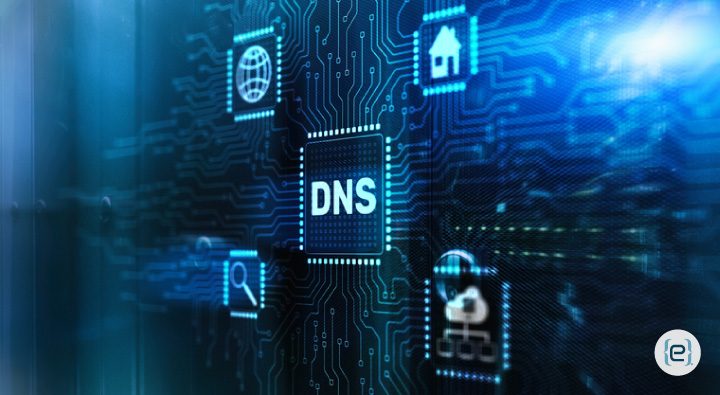DNS (Domain Name System) servers are the central nodes of the vast, interconnected Internet network. These servers translate human-readable website names into computer-understandable IP addresses, serving as the Internet’s equivalent of a phone book. All DNS servers are not made equal, though. Some put speed first, while others concentrate on blocking dangerous websites. We will examine secure DNS servers and how they can enhance network security in this blog post.
What is a DNS server?
The Internet’s address book is called DNS. Any time you visit a website, including emazzanti.net, your browser queries the DNS resolver for the IP address of the website. Sadly, most of these DNS requests and answers are insecure, So DNS encryption will improve security and privacy for users. Two DNS encryption protocols, DNS over TLS (DoT) and DNS over HTTPS (DoH), will be examined and their workings explained in this post.
Typically, DNS is used by applications that wish to translate a domain name into an IP address. Usually, the developer who creates the application doesn’t handle this separately. Rather, the coder composes something akin to fetch (“https://example.com/news”) and bides their time for the software library to convert “example.com” into an IP address.
The software library oversees locating, setting up, and discussing the DNS protocol (see the image below) to resolve the name that the application requests. The application has no control over the selection of an external DNS solution, or whether it offers privacy and security. Instead, the policies offered by the operating system of the device running the software, and the software library that is being used, determine this.
The Need for Secure DNS Servers
Conventional DNS servers are effective, but they lack security features, which is a significant disadvantage. Through an attack known as DNS hijacking, cybercriminals can take advantage of these vulnerabilities to direct users to malicious websites.
By incorporating an extra layer of security into the DNS resolution process, secure DNS servers address this issue. When you use DNS encryption, it is more difficult for snoopers to read your DNS messages or corrupt them while they are in transit. The DNS protocol, which encrypts DNS itself, has evolved, similar to the way the web itself transitioned from unencrypted HTTP to encrypted HTTPS.
The growth of private and secure communication and commerce has been made possible by internet encryption, and DNS encryption enhances user privacy even more. Between you and the resolver, there are two common methods for securing DNS traffic: DNS over TLS (2016) and DNS queries over HTTPS (2018). Both rely on TLS (Transport Layer Security) security, which is also utilized to encrypt the HTTPS protocol connection that you make with the website. Using a certificate, the server — be it a web server or a DNS resolver –authenticates itself to the client — which is your device — in TLS. Doing this ensures that no other party can serve as a resolver. The original DNS message is directly embedded in a secure TLS channel in DNS over TLS (DoT) technology. One cannot acquire or modify a name that is requested externally. This is how the target client application appears to be able to decrypt TLS.

Unencrypted DNS
It is easy to monitor and alter unencrypted DNS requests while they are in transit. ISPs are required to perform basic DNS filtering in certain regions of the world. The server may not respond at all, or it may respond with a different IP address, when you request the IP address of a blocked domain.
Generally, DNS requests to and from DNS servers are not encrypted. In a residential setting, the ISP assigns servers to a customer via DHCP. It is simple to monitor and alter unencrypted DNS requests while they are in transit. ISPs are required to perform basic DNS filtering in certain regions of the world.
Encrypted DNS
When you use DNS encryption, snoopers find it more difficult to read or corrupt your DNS messages while they’re in transit. The DNS protocol, which encrypts DNS itself, has undergone updates, like how the web transitioned from unencrypted HTTP to encrypted HTTPS. The growth of private and secure communication and commerce has been made possible by internet encryption. DNS encryption enhances user privacy even more. Between you and the resolver, there are two common methods for securing DNS traffic: DNS over TLS (2016) and DNS queries over HTTPS (2018). Both rely on TLS (Transport Layer Security) security, which is also utilized to encrypt the HTTPS protocol connection that you make with the website. Using TLS, the server verifies its identity to the client, be it a web server or a DNS resolver.
Certain parties anticipate that DNS resolvers will employ content filtering to:
- Block domains used to distribute malware.
- Ad blocking.
- Run parental control filtering and block domains associated with adult content.
- Block access to domains that host illegal content by local regulations.
To provide distinct responses based on the source network, use split DNS. One benefit of using the DNS resolver to block access to domains is that it can be done centrally, eliminating the need to re-enable it in every application. Regretfully, it is also severe. Let us imagine that example.com/videos/for-kids/ and example.com/videos/for-adults/ are two websites that host content from various users. Only “example.com” is seen by the DNS resolver, which may or may not block it. Due to their ability to examine URLs and restrict access to content, app-based controls such as browser extensions would be more useful in this scenario. DNS monitoring is not all-inclusive. Hard-coded IP addresses and DNS can be gotten around by malware, which can also query IP addresses using other techniques. But not all malware is that complex, so DNS monitoring can still be a powerful defensive measure.
Support for DNS resolution is necessary for all use cases involving non-passive tracking or DNS blocking. Implementations that rely on the current resolver’s opportunistic DoH/DoT updates maintain the same functionality that is normally offered over unencrypted DNS.
Sadly, as was already mentioned, its discounted versions are still in effect. Administrators can fix this by forcing endpoints to point to a DoH/DoT solution. The best way to accomplish this is to use secure device management programs (like Windows Group Policy, MDM, etc.).
Types of Secure DNS Servers:
Secure DNS servers come in various varieties, each with special characteristics of their own:
- Sending DNS queries over an encrypted HTTPS connection prevents eavesdropping and man-in-the-middle attacks, which in turn improves privacy and security. This technique is known as DNS over HTTPS (DoH).
- DNS over TLS (DoT): DoT, like DoH, adds an extra layer of protection by employing the Transport Layer Security (TLS) protocol to create a secure, authenticated connection between the client and the DNS server.
- A protocol called DNSCrypt is used to authenticate all DNS traffic that travels between a user’s DNS resolver and their computer. It stops DNS spoofing by guaranteeing that the answers you receive come from the service you’re interacting with.
Choosing a Secure DNS Server
When choosing a secure DNS server, consider the following factors:
- Privacy Policy: Make sure the DNS provider doesn’t record or sell your browsing information and respects user privacy.
- Security Features: Search for attributes such as support for DNSSEC, DNS filtering, and defense against DNS leaks.
- Performance: Your internet speed shouldn’t be appreciably slowed down by a secure DNS server.
- Reliability: To guarantee steady performance, pick a DNS server with a high uptime record.
Conclusion
A vital part of protecting online activity is the use of secure DNS servers. They shield users from dangers like DNS hijacking and man-in-the-middle attacks by encrypting DNS queries and offering extra security features. Using secure DNS servers is going to be more crucial for preserving online safety as cyber threats keep evolving.
Secure DNS, or Domain Name System protection is an essential component of an organization’s infrastructure for information security. Guaranteeing that DNS is reliable and secure safeguards the integrity of the Internet and can aid in preventing hackers from getting access to networks.
Secure DNS can help:
- Protect sensitive data, including IP addresses, by preventing unauthorized access to and alteration of DNS records.
- Business continuity: DNS attacks can cause downtime and interfere with network services, which can have an impact on businesses.
- Attacks by a man-in-the-middle: Lowers the likelihood of these attacks and stops malevolent parties from altering the data transferred via the DNS.
- DNS spoofing and hijacking: Users are less vulnerable to these attacks when they use encryption. Protects against phishing and malware attacks.
- Neutralize threats from botnets.
- Avoids typo.
- Can increase the speed of the connection.
Please feel free to contact an eMazzanti professional to find out more about DNS security options.







